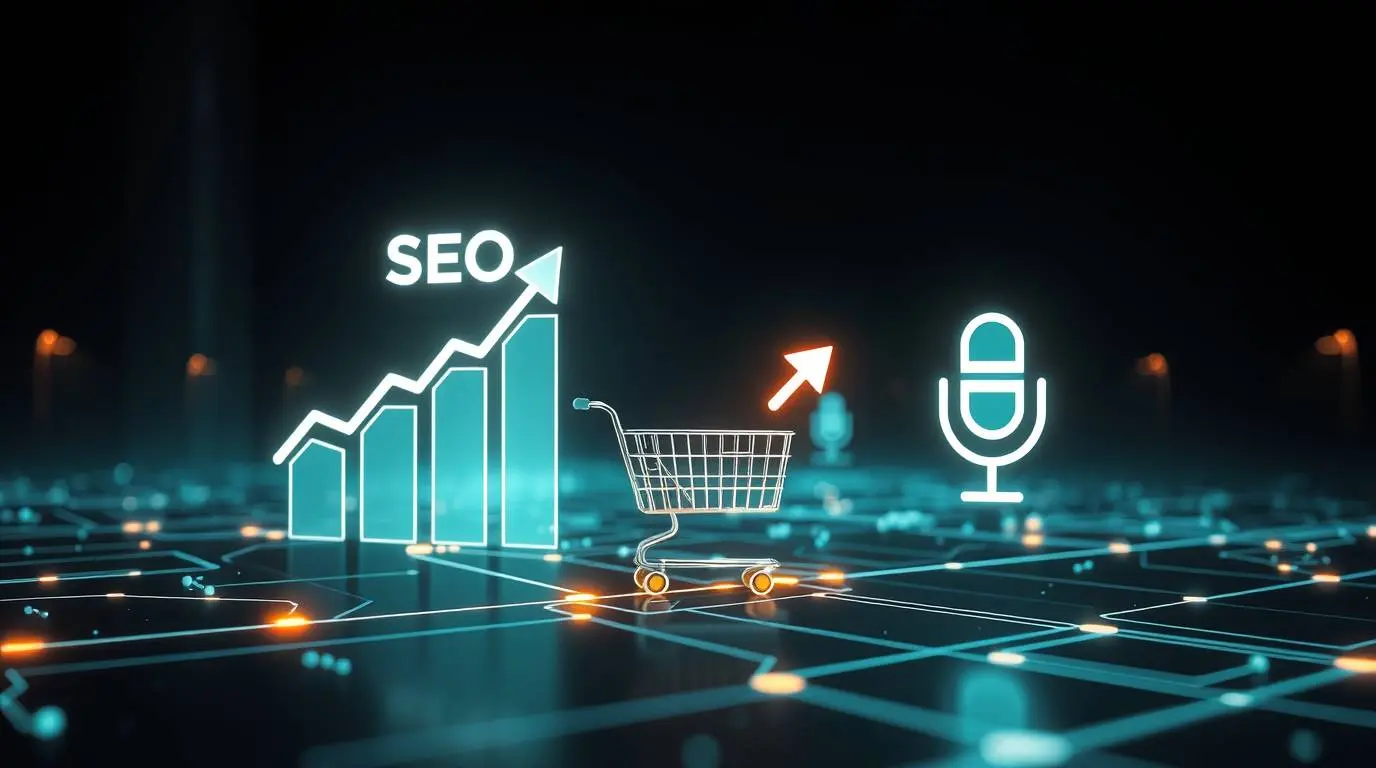Physical Address
304 North Cardinal St.
Dorchester Center, MA 02124
Physical Address
304 North Cardinal St.
Dorchester Center, MA 02124

Discover how AI eCommerce is transforming online stores in 2025! Explore 10 ways AI boosts sales, personalization & efficiency for your retail business.
Ever wondered how Amazon seems to know exactly what you want before you do? Or why that perfect pair of shoes keeps following you around the internet? The secret sauce behind today’s most successful online stores isn’t just good marketing—it’s artificial intelligence.
As someone who’s spent years helping small businesses navigate the digital landscape, I’ve watched AI transform from a buzzword to an essential eCommerce tool. And trust me, if you’re running an online store in 2025 without leveraging AI, you’re leaving money on the table.
In this guide, I’ll walk you through the 10 most impactful ways AI is revolutionizing eCommerce, from personalized shopping experiences to inventory management that practically runs itself. Whether you’re a side hustler with a budding Shopify store or a freelancer helping clients optimize their online presence, these AI-powered solutions can help you compete with the big players—without their massive budgets.
Ready to harness the power of AI for your eCommerce business? Let’s dive in!
Remember the days when personalization meant just slapping a customer’s name in an email? Those days are long gone. Today’s AI systems analyze hundreds of data points about each visitor to create truly individualized experiences.
AI personalization engines now consider:
Take Nosto, for example. Their AI-powered personalization platform can dynamically change your entire storefront for each visitor. Product recommendations, featured categories, even the imagery used can shift based on who’s browsing. A customer who frequently buys workout gear will see fitness products front and center, while someone who often browses your home décor section gets a completely different experience.
The results speak for themselves: businesses using advanced AI personalization report conversion rate increases of 20-30% and significant boosts in average order value. If you’re interested in more ways AI can boost your online business, check out our guide on AI business ideas for 2025.

“How do these jeans fit?” “Is this product compatible with my device?” “When will my order arrive?”
Customer questions never stop, and hiring 24/7 support staff is expensive. Enter AI-powered chatbots and virtual assistants—your tireless digital sales team.
Modern eCommerce chatbots like Tidio and Octane AI go far beyond basic FAQs. They can:
According to Juniper Research, chatbots will help businesses save over $8 billion annually by 2025, primarily through reduced customer service costs and increased sales efficiency.
What makes today’s AI assistants truly game-changing is their ability to understand natural language. Customers can ask questions just as they would to a human associate, and the AI understands context, remembers conversation history, and provides relevant responses.
For more on how AI is transforming customer service interactions, check out our comprehensive guide on AI marketing automation.
We’ve all experienced those eerily accurate “You might also like” suggestions. Behind them are sophisticated AI recommendation engines that drive up to 35% of eCommerce revenue, according to McKinsey.
But not all recommendation systems are created equal. The best AI recommendation engines like Clerk.io and Algolia Recommend use multiple recommendation strategies:
| Recommendation Type | Best For | Example Use Case |
|---|---|---|
| Collaborative Filtering | Established stores with lots of data | “Frequently bought together” bundles |
| Content-Based | New stores or unique products | “More items like this” suggestions |
| Contextual | Seasonal products or time-sensitive offers | Promoting sunscreen in summer |
| Visual Similarity | Fashion, home décor, visual products | “Shop the look” features |
The real magic happens when these systems adapt in real-time. Modern AI doesn’t just remember what you bought—it notices what you’re looking at right now and adjusts accordingly. That’s why the recommendations get better the longer you browse.
For more on creating compelling product content that works with AI algorithms, explore our article on AI content creation tools.
Ever noticed how airline tickets change price multiple times per day? That’s dynamic pricing at work—and AI has made it accessible to eCommerce businesses of all sizes.
Tools like Feedvisor use AI algorithms to:
The results can be dramatic. According to Harvard Business Review, businesses using AI-powered dynamic pricing see profit increases of 5-10% without losing market share.
What makes today’s dynamic pricing systems particularly powerful is their ability to segment customers and offer different prices to different segments. For instance, a first-time visitor might see a special discount, while a returning customer who rarely buys without a coupon might receive a different offer entirely.
Of course, transparency matters. The most successful implementations maintain customer trust by clearly communicating the value behind different price points.
If you’re interested in other ways AI can help optimize your business operations, check out our guide on making money with AI in 2025.

“I want something like this, but in blue.”
Traditional text search can’t handle this request, but AI-powered visual search can. Visual search technology allows customers to upload images or screenshots and find visually similar products in your store.
Platforms like Syte and Klevu have made visual search accessible to mid-sized eCommerce businesses. These tools can:
![Insert image of visual search in action, showing a customer photo and matching product results]
The benefits extend beyond cool factor. According to Gartner, businesses implementing visual search see 30% higher conversion rates from search users compared to text-only search.
For fashion, home décor, and other visually-driven categories, this technology is becoming a must-have rather than a nice-to-have. If you’re looking to implement visual elements in your marketing strategy, our article on AI art generators can provide valuable insights.
Inventory management is eCommerce’s least glamorous but most crucial function. Too much inventory ties up capital and warehouse space; too little means missed sales and disappointed customers.
AI-powered inventory management systems like those offered by Shopify Magic and Salesforce Commerce Cloud Einstein can:
The technology is particularly valuable for businesses with large product catalogs or seasonal fluctuations. According to Deloitte, AI-powered inventory management can reduce costs by up to 10% while simultaneously decreasing stockouts by 20-50%.
The most advanced systems don’t just look at your historical data—they incorporate external factors like social media trends, weather forecasts, and economic indicators to make smarter predictions. For more on automating business processes with AI, explore our guide on AI side hustles.

As eCommerce grows, so does online fraud. In fact, LexisNexis reports that every dollar of fraud costs online merchants nearly $3.60 in associated expenses.
Traditional rule-based fraud detection systems generate too many false positives, rejecting legitimate customers. AI-based systems like those from Signifyd and Adobe Commerce’s built-in fraud protection use machine learning to:
The most sophisticated systems consider device information, behavioral biometrics (how a user types or moves their mouse), time patterns, and hundreds of other signals to separate legitimate customers from fraudsters.
For businesses operating across borders, these systems are particularly valuable, as they can adapt to the unique fraud patterns of different regions.
“If you build it, they will come” doesn’t apply to eCommerce. Even the best online store needs visibility, and AI is revolutionizing how businesses optimize for search engines.
AI-powered SEO tools like MarketMuse and Clearscope help eCommerce businesses:
According to BrightEdge, organic search drives 53% of all website traffic, making it the single largest traffic channel for most eCommerce businesses. AI helps ensure your products appear in those critical search results.
The latest generation of AI content tools doesn’t just suggest keywords—they help create compelling product descriptions that convert by analyzing what language resonates with your specific audience. For more on optimizing your online presence, check out our guide to AI SEO tools.
The average cart abandonment rate hovers around 70%, according to Baymard Institute. That’s a lot of almost-sales slipping through the cracks.
Traditional recovery emails help, but AI-powered abandoned cart systems like those from Klaviyo and Omnisend take recovery to new levels:
The most sophisticated systems use predictive analytics to identify potential cart abandoners before they leave and trigger interventions like targeted chat support or special offers.
For eCommerce businesses, the math is simple: even a small improvement in cart recovery rate translates directly to bottom-line revenue. If you’re interested in more automated marketing strategies, our article on AI affiliate marketing provides valuable insights.

“Alexa, reorder coffee pods.” “Hey Google, add paper towels to my cart.”
Voice shopping is projected to reach $80 billion annually by 2026, according to Juniper Research. For eCommerce businesses, this represents both a challenge and an opportunity.
AI-powered voice commerce solutions like Blutag help online stores:
The key to success in voice commerce is understanding natural language search patterns. People search differently when speaking versus typing, often using longer, more conversational queries. AI helps bridge this gap, interpreting customer intent even when their phrasing is ambiguous.
For businesses selling consumable products or items that need regular replacement, voice commerce offers a path to effortless reordering that can significantly boost customer lifetime value.

Despite the clear benefits, integrating AI into eCommerce isn’t without challenges. Common hurdles include:
Fortunately, the eCommerce AI ecosystem is rapidly evolving to address these challenges. Many providers now offer:
For businesses just starting with AI, the best approach is often to begin with a single high-impact area—like product recommendations or chatbots—rather than attempting a complete AI transformation at once. For freelancers looking to offer AI implementation services, check out our guide on AI freelance services in 2025.
As we look toward the future, several emerging AI technologies promise to further transform online retail:
According to Statista, global spending on AI in retail is expected to grow to $23.4 billion by 2027, up from $5.9 billion in 2022. The businesses that thrive will be those that view AI not as a cost center but as a competitive advantage.
As AI in eCommerce becomes more sophisticated, concerns about data privacy naturally arise. Customers want personalized experiences but are increasingly wary about how their data is used.
Successful eCommerce businesses are finding the balance by:
According to Forbes, 76% of consumers are willing to share personal data if it leads to more personalized experiences—but only if they trust the business collecting it.
The good news is that newer AI systems can often deliver impressive results with less data than earlier generations required. Techniques like federated learning and differential privacy allow for personalization while preserving customer privacy.

Ready to bring AI into your eCommerce operation? Here’s a step-by-step approach:
Remember that AI is a tool, not a strategy. The most successful implementations align with your overall business goals and customer needs. For more on creating a comprehensive AI strategy, explore our guide on YouTube automation with AI.
In today’s hyper-competitive eCommerce landscape, AI isn’t just nice to have—it’s becoming essential for survival. The online stores that thrive will be those that harness AI to deliver better customer experiences, operate more efficiently, and make smarter business decisions.
Whether you’re running a side hustle on Shopify or managing a multi-million dollar eCommerce operation, AI tools exist at your price point and technical capability level. The question isn’t whether you can afford to implement AI—it’s whether you can afford not to.
As customer expectations continue to rise and competition increases, AI may well be the difference between eCommerce businesses that flourish and those that fade away.
Ready to transform your eCommerce business with AI? Start with one area where you’re currently facing challenges, implement a solution, measure the results, and grow from there. The AI revolution in eCommerce is just beginning—and it’s not too late to be part of it.